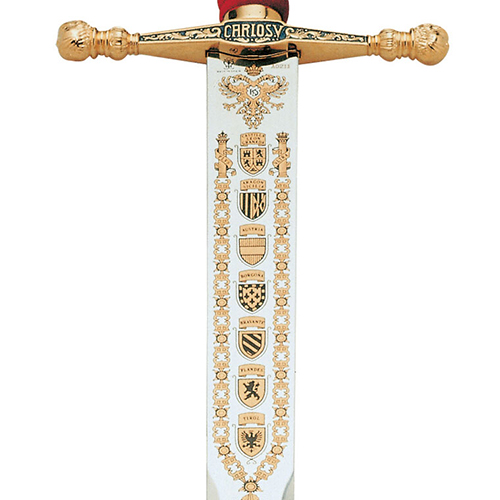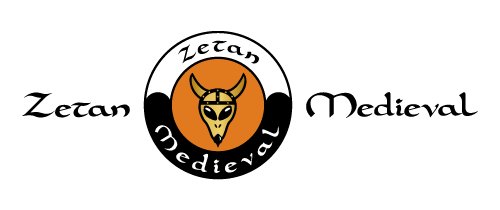HISTORY OF CHRISTOPHER COLUMBUS
Christopher Columbus was a navigator, cartographer, and expeditionary who discovered America on October 12, 1492, which was the first known encounter between European American cultures. He began the conquest of the recently conquered lands, and modified the behavioral habits of the Americans, imposing European customs. It opened a new shipping route from Europe to America. He died believing that this new route did not take him to a new continent but to the West Indies.
He was born in Genoa in 1451, although these data have always been questioned, and they are today, constituting a great mystery, especially since the publication of his biography by his son Hernando . He had 5 siblings and has always had a special inclination for the sea. He was a merchant taking his merchandise across the sea.
Researchers do not doubt its Genoese origin, based on documents in which Columbus himself declares himself to be from Genoa . Doubts arise from the fact that all his writings were in Spanish and not in Italian as would be logical . Others attribute Catalan origin to him, due to some Catalan expressions included in his writings. There are researchers who think that he was Galician, since in Pontevedra the surname Colón abounds a lot. And finally other studies lean towards his birth in Portugal.
From the age of 15 he became a sailor, getting to know all the trade routes of the Mediterranean. He settled in Lisbon for 10 years, until 1485, and continued sailing, which allowed him to discover other trade routes. During this period he learned cartography and drawing marine charts .
During his travels, he heard and believed the rumors that circulated at that time about the Earth being spherical and that other unknown lands existed in the west. So Columbus dared to appear before Juan II of Portugal himself, so that he financed a navigation plan to the West. But the project was rejected by the king.
At this time , Christopher Columbus married Felipa Moniz, whose family was well off financially. In 1480 the couple had their only son, named Diego. The fact that his wife’s family had money is believed to have started his project of sailing to the West, to open new trade routes. His wife died a few years later, and Colón became romantically attached to Beatriz Enríquez. From this relationship a son was born, Hernando in 1488.
Contacts with Portuguese sailors and various cartographers increased his belief that there were unexplored lands sailing west. He had access to the letters and maps of Paolo Toscanelli, in which the feasibility of reaching India was affirmed.
Added to this is what Columbus was able to hear from his father-in-law and, relying on the letters and maps drawn up by Paolo dal Pozzo Toscanelli, addressed to King Alfonso V of Portugal, to which he had access and where the possibility of reaching India by heading west is exposed. This finally convinced him, in case he had any little doubt, that the Earth was a sphere, and he came to calculate the distance to the new lands. But his calculations were quite wrong. Hence his false certainty of having reached the Indies, when he had arrived on a new continent.
When the King of Portugal rejected his project, Columbus, who was a very tenacious person, decided to present his plan to the Catholic Monarchs of Spain. He made good relations with people close to the kings , and thanks to the queen’s confessor, he managed to get the Royal Council to receive him in audience, in January 1486. Said Royal Council met another 2 times to discuss the issue, and after several years they denied him support for his project. In 1491 the queen, who, if she believed in Columbus’s project, convened the Council again, and again her project did not see the approval of the councilors. This was a hard blow for Columbus and he decided to leave Spain, but at the last moment the friars Juan Pérez and Diego de Deza, as well as the aristocrat Luis de Santángel, managed to get King Ferdinand to support the project.
After the capitulations of Santa Fe, signed by the kings in 1492, in which Columbus expressed his economic and social conditions, navigation began, departing on August 3, 1492 from Palos de la Frontera, with 3 caravels, the Niña, the Pinta, and the Santa Maria. He was accompanied by the experienced sailors who were the Pinzón brothers, Martín and Vicente. They made a technical stopover in the Canary Islands. On October 12, 1492 Rodrigo de Triana shouted Earth! He called this island San Salvador. They also arrived in Cuba and Santo Domingo, called Juana and Hispaniola , respectively. In Santo Domingo, the Santa María was wrecked and its remains were used to build Fort Navidad.
Columbus’s second voyage began on September 25, 1493 with 17 ships. They found Fort Navidad destroyed by the natives, so Columbus established the first city, La Isabela, where a group of soldiers stayed. He was also in Guadeloupe and Jamaica. On his return to Cádiz he was censured for mistreatment of his sailors.
On his third trip, he left Sanlúcar de Barrameda with 6 boats in 1498. He arrived at Trinidad Island and discovered the mouth of the Orinoco River. He continued with his expeditions, and also drew maps of the coasts of South America. The numerous complaints against Columbus forced the Catholic Monarchs to order Francisco de Bobadilla to arrest Columbus and his brother Bartolomé, and to bring them back to Spain. Humiliated and handcuffed, he returned to the port of Cádiz, but was not in jail for more than a few days.
Columbus’s fourth and last voyage was undertaken in April 1502, with the aim of finding a supposed strait that would lead them to Asia . In his journey he was in Honduras, Costa Rica and Panama. He returned to Spain in 1504 in great misery and sick with gout. There is no doubt about the total failure of this last trip of Columbus to America.
Christopher Columbus died in Valladolid on May 20, 1506 , and his remains now rest in the Monastery of La Cartuja, in Seville.
Américo Vespucci, a native of Florence, produced a cartographic book in which he demonstrated that Columbus had discovered a new continent unknown until then. Precisely because of this Florentine, America is called America
The discoveries of Christopher Columbus, apart from uniting two unrelated worlds, opened the door to conquests and, therefore, to the creation of empires, especially the Spanish and Portuguese ones. However, recognizing Columbus as an extraordinary navigator, some believe that he was not the first European to reach America, but no one takes away from him the great merit of being the first to create a route between Europe and America.
THE SWORD OF CHRISTOPHER COLUMBUS
There is no historical record that Christopher Columbus carried a specific sword with him during his voyages to America. It is unlikely that Christopher Columbus carried a sword with him, as travel at that time was difficult and dangerous, and space and weight were limited. Travelers preferred to carry firearms and projectiles rather than swords.
Some later accounts of his life may have associated Christopher Columbus with a sword, but there is no historical evidence to support this hypothesis.
Although there are many paintings where Columbus appears with a sword, it should not be inferred from this that the sword that Columbus carries had the shape seen in paintings, since the author of a painting in the 15th century always tends to go to the imagination to represent an event such as the discovery of America. Proof of this is that in the group paintings the character of Columbus has a different appearance.
Columbus’s sword has not been found and since we are in 1492, several types of sword were used in Spain, although the most common was the rapier. In those years in Spain, the bow hilt, the simple cross and the double set of hawks with the lower arched or fallen and the Arab hilt of fallen hawks among others, were used simultaneously, all of them ornamented contending with the horseshoe arch and usually embellished with engravings and patterns.
And having said this, we add that the numerous replicas that circulate around the world of the supposed sword of Columbus, present us with a cross sword almost one meter long, with 13 cm. of cross. The pommel is spherical, garnished with curved hawks and decorated in silver that completely covers the handle. Its blade is double-edged and grooved and in it you can see carvings of crosses and other symbols. Its composition is carbonized steel, the bronze handle decorated with silver threads.
After this presentation, we humbly believe that, despite not being experts in the sciences of history, research and archaeology, and exposing ourselves to criticism from those versed in these issues, and we dare to say that we have many doubts about Columbus having a permanent sword, since our character was not a man of arms, and it is very possible that for his defense he carried a firearm. However, if he used a sword, this circumstance would be circumstantial and not continuous.
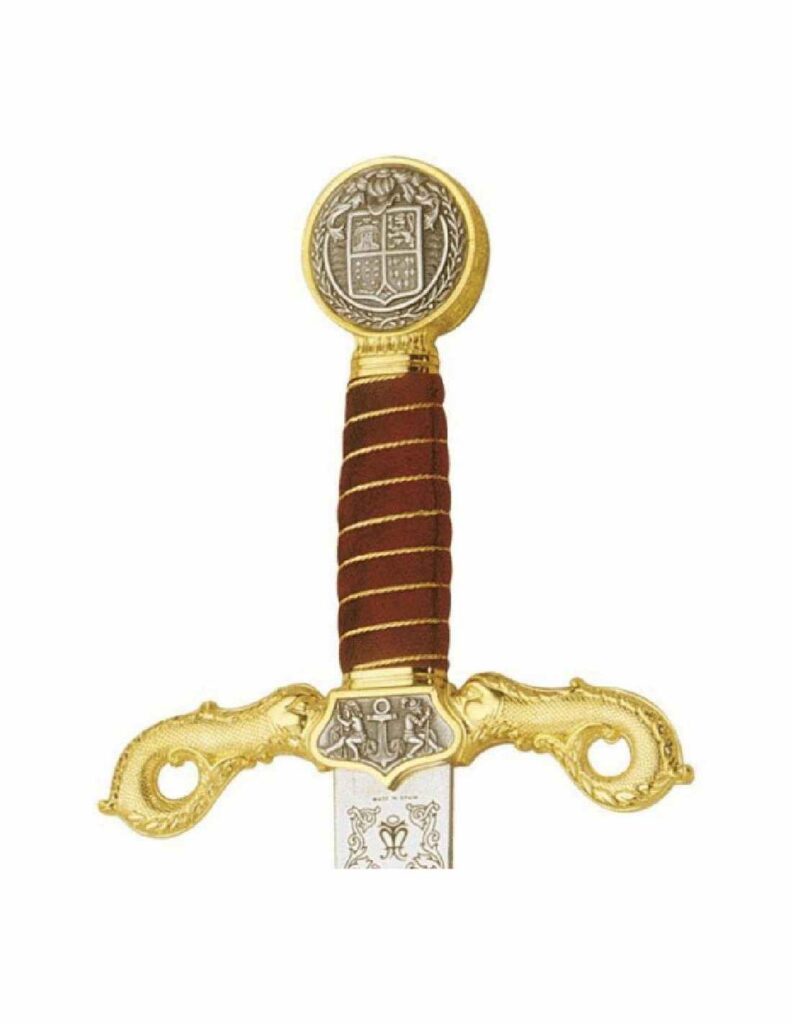
WHAT DID COLUMBUS BELIEVE IN TO REACH HIS DESTINATION?
Columbus was convinced that the Earth was spherical, and therefore Asia could be reached by crossing the sea in a Westerly direction. And he was right, but he failed in his calculations about the distance between Europe and Asia, and he fell very short when it came to deducing the size of the Earth. And the mistake was big, nothing less than a continent in the middle.
WHAT WAS COLON REALLY LOOKING FOR?
On his first voyage, Columbus had the intuition of finding new islands, he was also sure of reaching Asia, across the Atlantic, specifically Cipango, present-day Japan, which was said to be a land where gold abounded.
WHY DID COLUMBUS WANT TO GO TO INDIA?
In addition to the gold from Cipango, Columbus wanted to reach India to trade with the natural resources of these lands, which were especially rich in black pepper and other spices, establishing a new, shorter and more reliable route than the one used until then, which necessarily passed for encircling Africa in the southern part .
WHERE WAS COLUMBUS BORN?
There are more than ten theories about where Columbus was really born, from when he was in the bosom of a Jewish family in Ibiza, until he came into the world as a descendant of Galician nobility. However , the hypothesis with the most weight is the one that preaches that its origins are in Genoa, the Italian city where our character first saw the light of day in October 1451. But the Island of Chios, Sardinia, Corsica or Portugal also claim its paternity. . Spain is not left out of the equation and various places are attributed to it as its birthplace, Espinosa de Henares, Felanix (Mallorca), Pals (Catalonia), Plasencia and Polo (Pontevedra).
Columbus himself never wanted to speak clearly about his native town. Why? It is not known, but this subject has also made rivers of ink flow, and in which we are not going to enter.
Of all the theories that run through the country about the Spanish origin of Columbus, without a doubt the one that takes the cake is the Galician one. Associations, museums, specialist conferences, documentaries, and even a film have been built around it. All of them stubbornly support the Galician nature of Columbus. This theory had its main promoter in a writer who died at the beginning of the 20th century, Celso García de la Vega. For many years he snooped in archives, libraries and anywhere that there was a document on Columbus, and he dared to question, in Madrid, in the Geographical Society, in front of a large audience with academic training, and supported by his research, the Genoese origin of Columbus. The writings on which he supported his theories have been examined by the Scientific Police belong to the time of Columbus, and the paper is made by hand, a very widespread custom then. This theory is also supported by the fact that the surname Colón exists in Pontevedra. Although in recent years, the Galician theory has two other validating signs of it: the words used by Columbus in his writings, and the place names he used to name places, many of them have their corresponding in Galicia. Another argument in favor of this theory is that the ship Santa María, which Columbus captained, was called by the sailors La Gallega .
For centuries, studies have continued to find out the true origin of Columbus. None with irrefutable results, although, as we have said before, the “official” version supports its Genoese origin.
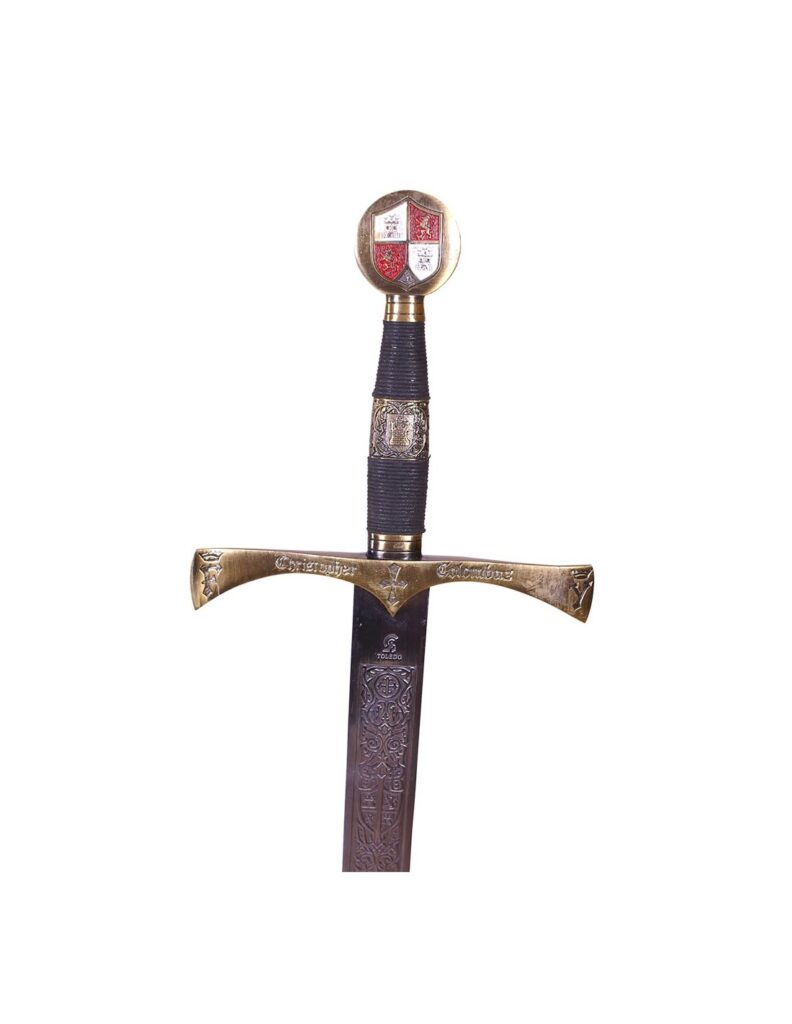
MARCO POLO STORY
Marco Polo was a merchant from the Republic of Venice. In the 13th century, his passion for travel and adventure took him to the limits of China. He knew and served the Mongol Emperor Kublai Khan. Everything he saw and learned was recorded in the Book of Wonders, a book that inspired other great navigators such as Christopher Columbus or Vasco de Gama.
Marco Polo came into the world on September 15, 1254 in Venice , in the bosom of a family of wealthy merchants whose major businesses were in the countries of the East. His father and uncle, Niccolo and Matteo , also expert explorers, go away for 15 years and meet the Kublai Khan. On their return to Venice they bring with them a letter from the Khan to the Pope, in which he asks for a hundred missionaries to Christianize China. But right now Peter’s chair is vacant and they must wait for the election of Gregory X, as pope, to deliver the message to him.
In 1271 Niccolo and Matteo returned to China, accompanied by Marco, who was only 17 years old, and 2 Dominican monks, the only religious they managed to convince. The friars left the mission immediately. The three Poles continue the adventure following the Silk Road that allowed commercial exchanges between the West and the East . Sometimes on horseback and sometimes on foot. They cross Armenia, and arrive at Tabriz, near Persia, and Marco Polo is amazed by the great activity of the city. They cross a desert in central Persia. In the Pamirs they save a series of mountains from perpetual snow. Then another desert, that of Goby , taking a year to cross it.
Four years after their departure from Venice, the Poles arrive in China and present themselves to the great Khan, in Cambaluc , the new capital of China, near present-day Beijing. Kublai Khan, grandson of Genghis Khan, receives the Poles very kindly. In this time Marco Polo has learned a lot of oriental languages. And this is enough for him to go to the Khan’s diplomatic service. His father and uncle are appointed as military advisers. As a diplomat, Marco Polo toured many surrounding countries, and was even appointed Governor of Yangtgeou .
They served the Khan for 17 years and accumulated a great estate. It was time to go home, but the Khan disagrees, and refuses to let them go. They had to wait until 1292 before they could return, with the mission of giving protection to a Mongol princess on her trip to Persia. Three years later they arrive in Venice. Their compatriots are amazed at the stories they tell, as well as the riches they bring with them.
In 1298 Marco Polo is captured and taken prisoner in a battle between Venice and Genoa . He suffers two years in prison and befriends his cellmate Rustichello from Pisa, to whom he dictates his incredible adventure in the Khan’s land. From there arises the book entitled The Book of Wonders or the trips of Marco Polo. The book was widely distributed and circulated throughout Europe because of the invaluable information about the Far East it contained.
At the age of 45, Marco Polo decides not to travel again and gets married with three daughters . Venice died on January 8, 1324 at the age of 70.
THE SWORD OF MARCO POLO
Marco Polo’s sword, according to legend, was a magical sword, which our hero took to China. Legend has it that it was made by a Chinese blacksmith, and it was magical because it could cut anything and never dull. Not finding any historical evidence of this, it is believed that it was a fantasy created after Marco Polo died. The name of that sword is not known.
Most commonly, Marco Polo’s sword should be the famous cinquedea _ It is a sword from the Middle Ages widely used in Italy as a personal defense weapon. Its blade is long and thin with a curved shape. Cinquedea means 5 fingers in Italian, which alludes to the width of the blade. This blade is made of steel, the length of which ranges from 30 to 40 cm. The handle has a prominence in the center, which facilitates its grip and a “U”-shaped guard, which allowed it to safeguard the wearer’s hands. The sword also has a curved finial which allows it to strike and pierce. In our times the Cinquedea is an emblem of the transalpine culture and is highly appreciated by those learned in ancient weapons.
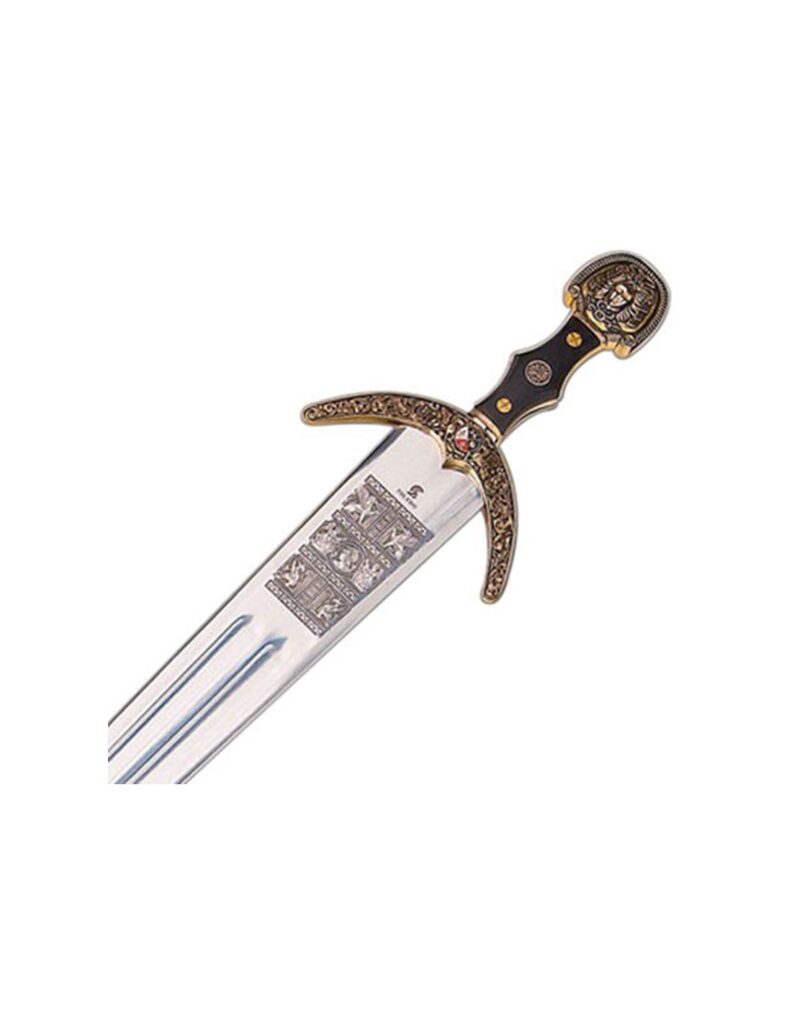
WHO WAS MARCO POLO AND WHAT ACHIEVEMENTS DID HE MAKE AS A SAILOR?
His voyages were fundamental in making the first efficient maps of Asia that were drawn in Europe, and stimulated Christopher Columbus’s fascination with the Orient, which led to the discovery of America in 1492, although Columbus himself always thought that he had reached the Orient by sailing. towards the West.
WHAT WAS THE MAIN ACHIEVEMENT OF MARCO POLO?
He was the first European to reach parts of Asia ever trodden by any man born in Europe. He participated by commanding a ship in a battle between Venice and Genoa, in which he was captured and imprisoned for 2 years. His book Viajes de Marco Polo, is a book of stories of all his experiences in his trip and stay in the Far East. That book became very popular throughout Europe and served as an inspiration to other explorers.
WHAT ARE THE MAIN CONTRIBUTIONS OF MARCO POLO?
It extended the limits of the known world in the 13th/14th century, providing Europeans with the opportunity to learn about the Asian continent, through its territories, villages, traditions, history, and riches. His father Nicolo and his uncle Maffeo were the first Europeans to travel the Silk Road, from Constantinople to Beijing.
THE KING SOLOMO
Solomon succeeds David on the throne of Israel, and during the time he was king, his people were admired and respected by neighboring nations. One night, in a dream, the Lord spoke to him and said, “Ask me what you want.” Solomon replied: “You have given me a great town and I am afraid that I do not know how to govern it. Therefore, I just want you to give me the wisdom to lead the people of Israel well, to know how to distinguish good from evil.” To which the Lord replied “Because of your wise and prudent decision I grant you that wisdom that you have demanded of me and, furthermore, for not asking me, I will shower you with riches, and if you comply with my laws I will also grant you a long life” And so it actually happened. Solomon ‘s wisdom was the greatest of all known sages and his fame was known and admired by all peoples.
In the four hundred and eightieth year, the fourth of his term, the king conceived to build a great temple for Yahweh. Rectangular silver its stones were covered with cedar and gold. Inside the temple, the Ark of the Covenant was venerated, as well as the altar, all covered in gold. It was an extraordinary construction work that required a huge amount of materials to carry it out and nearly 200,000 men worked on it. The works were completed in 7 years. The temple was offered to God. All of Jerusalem came to its inauguration, marveling at such a construction. Then Solomon prayed to Yahweh before all Israel and said. “Lord, your greatness is so great that it does not fit in this world, and even less in this place that we have built for you, more deign to listen to us when we pray and we will venerate you in this place”
King Solomon was the greatest of all the sovereigns of the earth for his possessions and his wisdom. They all paid homage to him and showered him with a multitude of gifts, some of which were made of precious metals. This situation lasted all his life.
In the book of Kings 3:16-28 the best-known story of Solomon is told in our days. At that time two prostitutes came to the king and stood before him. One of them said: -Oh, my lord! This woman and I lived in the same house. I gave birth while I was at home with her. And it happened that three days after my delivery, this woman also gave birth. We were both together, and no one from outside was with us at home. Only the two of us were at home. One night this woman’s son died, because she lay on top of him. Then she got up at midnight, and while I, your servant, slept, she took my son from me, and put him in her bosom; and laid her dead son in my bosom. When I got up in the morning to nurse my son, behold, he was dead. But I looked at it well in the morning, and behold, it was not my son, the one I had borne. Then the other woman said: -No! But my son is the one who lives, and your son is the dead one. And the other said again: -No! But your son is the dead one, and my son is the one who lives. Thus they spoke before the king. Then the king said: –This one says: “My son is the one who lives, and your son is the dead one”; and the other says: “No! But your son is the dead one, and my son is the one who lives.”–And the king Added–: Bring me a sword! They brought the sword before the king, and immediately the king said: – Cut the living child in two, and give half to one and the other half to the other! Then the woman whose living son was spoke to the king, because her bowels were moved by her son, and she said: “Oh, my lord! Give her the living child; don’t kill him But the other said: “It won’t be for me or for you.” split it. The king responded by saying: “Give her the living son. Don’t kill him; She is her mother. All Israel learned of the sentence that the king had given, and they were afraid of the king, because they saw that in him was wisdom from God to administer justice.
CHARACTERISTICS OF THE SWORD OF KING SOLOMON
Mythology says that the Sword of Solomon was a contraption and magical weapon forged in ancient times, and that it could reject the countless spells of djinns and geniuses. As its name makes clear, it is a sword that some point out belonged to King Solomon, the son of King David of Israel. Said King Solomon, who everyone thinks was a mysterious character, endowed with great wisdom, as well as mastering sorcery, was the one who locked the first djinns in vessels and other objects, because they disobeyed God.
Although the most famous fantastic artifact attributed to King Solomon is a ring, it would not be surprising if, as he was also a great warrior, he had at least one sword. It is said that it was an Israelite sword that emitted a great white light.
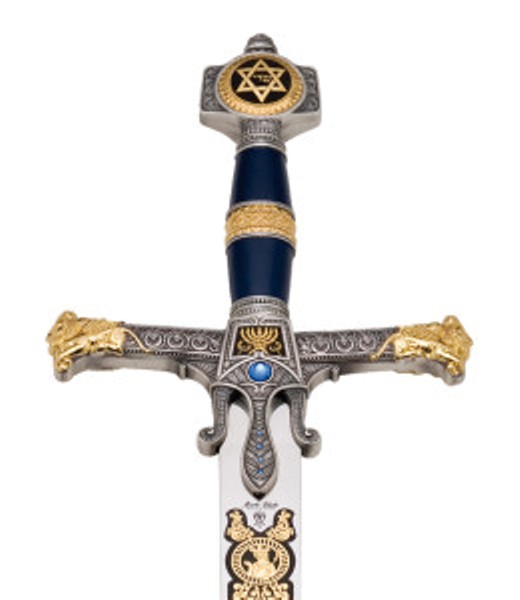
FICTITIOUS HISTORY OF THE SWORD OF SOLOMON
The fiction of our days presents us with the sword of Solomon as forged by his own command using only magical minerals. So he wanted to be the owner of a weapon capable of fighting against the magic of geniuses. Solomon with this sword, operating in multiple battles, managed to capture all the geniuses, with which they were inoperative to do evil, he would have used it in his odyssey and battles to imprison each one of them, thus preventing them from doing evil. When Solomon died, his sword stopped Nefereth , who also used it to disable the power of the jinn. When Rayah , a djinn , fled, Nefereth passed the sword to Kóatl so that he could counter Rayah ‘s magic . This got in a showdown. Then the sword passed back into the hands of imprisoning her again, taking her before Gran to imprison her once more. It can be assumed that after this confrontation the sword returned to Nefereth ‘s hands.
The sword had its only bibliographic appearance in Kóatl El Defensor vs Rayah La Genio , a 2019 crossover comic.
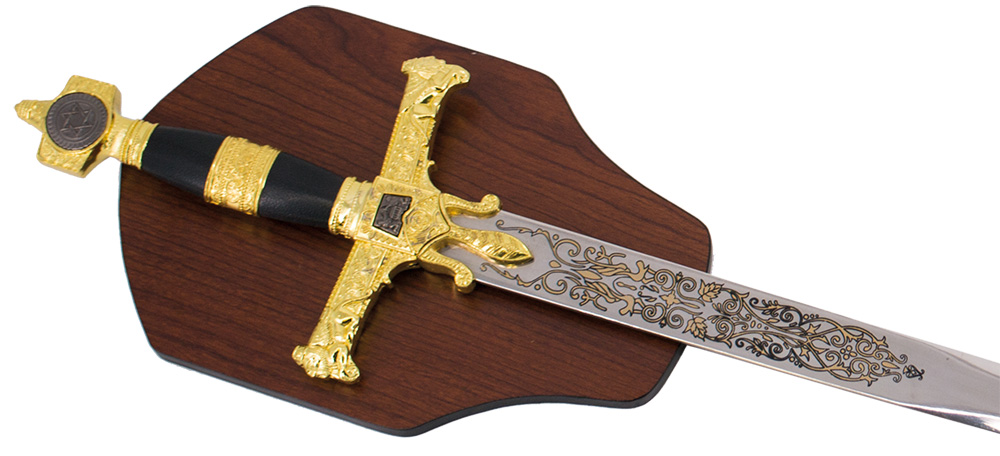
WHAT HAPPENED TO SOLOMON’S TREASURE?
Solomon ‘s Treasury was first in the Temple of Jupiter Capitolinus, and later it was transferred to the imperial palaces. Its deposit in these palaces ceased in the year 410 when the Gothic king Alaric took Rome. He transferred it to Toulouse, which was then the capital of the Goths.
WHAT POWER DID THE RING OF SOLOMON HAVE?
The Arabs called it as the Khatim Sulaymani . There is no reference to his cradle, and that is why some fabulists dare to point to the archangel Michael as the entity that supplied the ring to Solomon and used it to subdue the demons, causing them to act in his favor for good government. from town.
WHAT IS SOLOMON’S GRIMORY?
The Lemegeton Clavicle Salomonis (in Spanish, The Lesser Key of Solomon), or simply Lemegeton , is a grimoire by an unknown author from the 17th century, and one of the best-known occult books. In the lesser key of Solomon we can find, among many other things, representations of spirits, and also precise spells to subdue these spirits to the wishes of the conspirators.
THE SONG OF ROLDAN
The Song of Roldán is the most archaic epic song of the French epic. The transcription of the Song that specialized critics believe to be the most beautiful is the one found on the pages of a manuscript from the Bodleian Library in Oxford, transcribed into a dialect of Old French in the 12th century.
The work, which is anonymous, was copied by an abbé who, according to what seems to have been carried out, did not limit himself to transcribing the version, but rather made a compendium of the previous adaptations , a fact that contributed to show the excellent artistic quality and kindness. cult of singing Of the clergyman cited as author, there is news that his name was Turoldo, as is clear from the last verse of the poem. We only know of this cleric that his name was Turoldo , as it appears in the last and enigmatic line of the poem: “Ci fait la geste de Turoldus declinet” (Here ends the deed of Turoldo)
Charlemagne, who has already taken all of Spain, except for Zaragoza, sends Ganelon to the city of the Ebro to make a pact with the Moorish king Marsilio. Ganelón, who maintains serious differences with Roldán, Charlemagne’s nephew, negotiates with Marsilio for betrayal. When the French are returning to France, they are harassed by the Arabs of Zaragoza, in a place known as Roncesvalles, Roldán falls mortally wounded, even more so he has time to sound the olifante to notify Charlemagne. He arrives late and is faced with a countryside full of French corpses. At that moment the sun stops, then the Franks go out in pursuit of the Arab perpetrators of the massacre, Marsilio’s troops, and after a hard fight they manage to defeat them. But the tragedy does not end here, because when Alda, Roldán’s lover, dies when she learns of Roldán’s death.
The historical basis of Cantar de Roldán cannot be denied, but the author modifies some parts of the narration at his convenience, seeking, we suppose, a greater descriptive capacity of the epic. Among the multiple modifications is considering that in the year 778 the entire Iberian Peninsula was taken over by the Muslims .
The Song is made up of hendecasyllabic verses, assonances, with heterogeneous runs in their length, merging, in this way, elements of cultured metric with vulgar metric.
The protagonists have all the characteristics of epic songs, especially the very special relationship that exists in this type of book, between the hero and his horse or sword .
Charlemagne, appears as a prudent old man and respected for his wisdom. He is protective of his nephew Roldán as if he were his father. It is said that he has revelations that warn him of upcoming dangers.
Roldán , a very brave young man and a very good fighter on the battlefield. But that bravery sometimes turns into recklessness, which together with his pride will lead the French to defeat.
Oliveros , Roldán’s inseparable and loyal comrade who tries to stop Roldán in his most excessive decisions. It is an example of good sanity and reflection that are worthless in the face of Roldán’s hasty stubbornness.
Turpin , archbishop, but at the same time a great warrior on the battlefield. It constitutes an example of the support of the Christian religion to the kings of the time.
Ganelón , the opposite of Roldán del Cantar, is a selfish, dishonest and false individual. He is considered the culprit of the defeat of the Franks at Roncesvalles.
THE DURANDAL SWORD OF ROLDÁN
This weapon is of French origin, which is said to be the sharpest sword in the world known. It appears in “El cantar de Roldán”, a French poem from the 11th/12th century, in which the battle of Roncesvalles (year 778) is recounted. It is the sword of Roldán, the hero of the song, nephew of Charlemagne, known as Durandal (or Durandarte). This sword was considered unbreakable and great. Mythology says that it was Volundr who made Durandal. This Volundr was a Nordic blacksmith, who made a multitude of swords, he is best known for his evil, and for using magical mechanisms in everything he forged.
Durandal exhibits various Christian relics. Some legends say that an angel gave the sword to Charlemagne, while others dare to affirm that it was one of the swords of Hector of Troy. According to the song, Roldán carried and used Durandal in the battle of Roncesvalles. With it he cut off the hand of the King of Zaragoza, Marsilio, and killed his son. Faced with imminent defeat and when he is about to die, Roldán did not want his sword to pass to the Saracens and tried to break it against the rocks, then an opening was opened between the rocks, more than 100 meters long, which today is known as the Roldán gap. Another legend says that he threw it into the air and it stuck to a rock in the city of Rocamadour, in France. And indeed there is a sword stuck in a rock in this city, and some consider it the true sword of Roldán, especially the French. Those who claim the Sanctuary of Rocamadour as the final destination of the sword of Roldán. Another destination where Durandal is said to be, is Lake Carucedo in El Bierzo (León). How do I get there? Nobody knows, but the neighbors are convinced that it is at the bottom of the lake. There is still another possible destiny, and here appears other characters Bernardo del Carpio, who fought in Roncesvalles. It is said that the sword passed into his possession when Roldán died. This Bernardo was buried next to Durandal in a cave near Aguilar de Campo (Palencia). However, the sword should still continue its journey. In 1522 Carlos V, aware of the stories that were narrated about Bernardo del Carpio, made the decision to seize the sword Durandal, which was in his possession until his death. And if this last possession is true, we can now admire the famous sword of Roldán in the Royal Armory of Madrid.
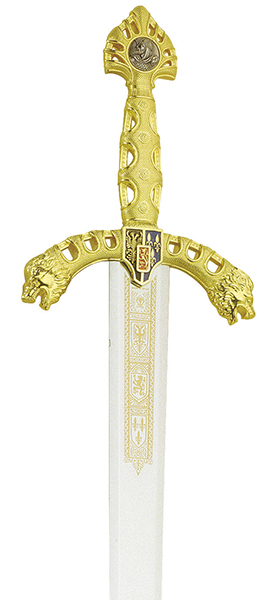
HOW DID ROLDÁN GET HIS SWORD?
It was Charlemagne, his uncle, who at the time Roldán was invested as a knight, at the age of 17, gave him Durandal. Sword that contained various relics. When death was knocking on Roldán’s door, in the battle of Roncesvalles, he tried to break his sword so that it would not pass to his enemies as spoils of war, but he only managed to split the rock in which he was trying to break it, remaining unharmed. .
HOW IMPORTANT WAS THE SWORD FOR ROLDÁN?
Durandal contained various relics of Saints, which are mentioned by Roldán himself, in El Cantar, and which sought to protect the bearer of the sword from his enemies: A piece of Saint Peter’s tooth, a few drops of Saint Basil’s blood, some hairs of the head of Saint Dionysus and a piece of the cape of Saint Mary.
WHO KILLED ROLDÁN?
Roldán dies in the battle of Roncesvalles, and some attribute his death to Bernardo del Carpio from Palencia, who keeps his sword Durandal.
Roldán, the hero of Roncesvalles, who commanded the French troops in the rear, protecting the hosts of Charlemagne who were withdrawing from Spain through the Pyrenees, says in the Song of Roldán that he was betrayed and assassinated in an ambush.
WHO WAS THE BLACK PRINCE
Edward of Cornwall, known as The Black Prince, was born in Woodstock in 1330 and died in London in. He was Prince of Wales and Aquitaine. The son of English King Edward III, he was named Prince of Wales, as heir to the English throne in 1343. He is commonly known as the Black Prince, due to the color of the armor he wore. Highly respected as a knight and an excellent military strategist. He was a perfect gentleman, as well as an exquisite model of a military leader. In the year 1345 he took an active part in the 100 Years War. In these times England and France in a war that never seemed to end. Within the battles in which our character intervened in said war, it is worth mentioning the Cotentin ride . In 1356, the English, led by the Black Prince, soundly defeated the French at the Battle of Poitiers. According to the chronicles of this battle, the English numbered 7,500 men, while the French had a much larger number of troops, about 50,000. The victory of the English was such that they captured the French king Juan II, the Good. The Black Prince obtained the appointment of prince of Aquitaine, whose capital was Bordeaux.
Later , the Black Prince participated in the fight for the Crown of Castile, King Pedro I and his half-brother Enrique de Trastámara, who was supported by the French. For this, the Treaty of Libourne was signed between Pedro I and the Black Prince. Later the King of Navarre, Carlos II, joined the treaty. This aid received from the English and Navarrese did not come cheap to Pedro I of Castilla, and was estimated at: 550,000 florins, the lordship of Vizcaya and the town of Castro Urdiales, as well as substantial benefits for English merchants who worked with the Crown of Castilla .
In 1367 , the soldiers of the Black Prince entered the Iberian land through Navarre, where they joined the troops of Carlos II, King of Navarre. They continued their advance towards the south, meeting their opponents in Nájera, on April 3, 1367. The troops of the Black Prince and the monarch of Castile Pedro I achieved a resounding victory over Enrique de Trastámara and his French allies in the battle of Najera. Before the combat there was an exchange of letters between the 2 sides. The Black Prince offered peace, as long as Pedro I of Castile was replaced on the throne, from which he had been illegitimately dispossessed. In the end there was no agreement and the confrontation between the two parties took place. The intervention of the English archers, great experts in handling the bow and arrow, was decisive in achieving victory, one of the greatest victories of the English army. Enrique de Trastámara managed to escape his disaster, but many of his men were taken prisoner, among them the Breton Bertrand du Guesclin.
Despite the victory, Pedro I did not comply with the agreement, since he did not have the agreed money. Under these circumstances, the Black Prince left Castile and headed for Gascony , signing a confidential pact with the king of Aragon, Pedro IV, the ceremonious in August 1367. We were in these when the fights between Pedro I and Enrique de Trastámara, who had fled to France after the defeat at Nájera, intensified again. Then the Black Prince and the representatives of Aragon, Navarra and Portugal met in Tarbes , and agreed to propose the Black Prince as King of Castile, once the hostilities to recover the territories claimed by Aragon, Navarre and Portugal ended. But the agreement was left in the water, as the King of Portugal changed sides, Pedro I having eliminated his half-brother in the battle of Montiel in 1369. After this, the Black Prince resolved to abandon forever the war problem that had taken to Castile.
Our protagonist fell ill in 1370. The illness worsened, and as a result of this, the Prince’s brother, John of Gaunt, Duke of Lancaster, was appointed substitute governor of Aquitaine. The Black Prince died soon after, in 1376, before his father, King Edward III. Many believe that it was in Spain, where he acquired the disease, which ultimately killed him.
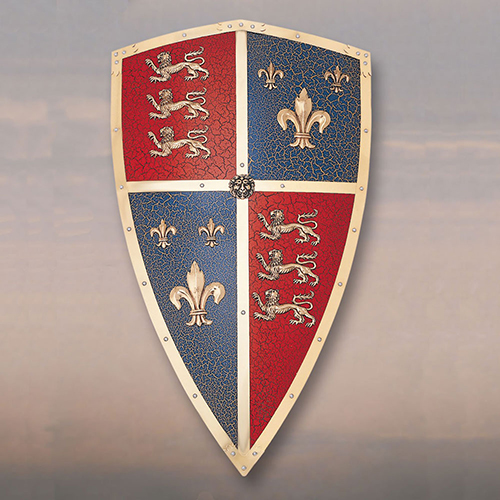
THE SWORD OF THE BLACK PRINCE
The Sword of The Black Prince is said to be in a personal collection in England. The Black Prince, son of Edward III and father of Richard II, stood out as a great fighter. During the English Civil War the sword disappeared, which caused a great scandal that splashed Cromwell himself. The blade of this sword is made by hand in carbonized steel. The handle is made of wood, wrapped in black leather. Complement of this sword is a wooden scabbard, also wrapped in black leather. You can also see small steel motifs on it.
In 14th century England, the sword was a very popular weapon valued for its ability to inflict serious wounds on the enemy, often leading to their death. They were used both on horseback and on foot, the useful combat techniques being different. Swords from the 14th century were ordinarily made of hand-forged steel, with no common shape or size. From these swords come the two-handed sword, the short sword and the greatsword. The nobles generally added ornaments and epigraphs to their swords.
Having said all of the above, there are many legends about The Sword of the Black Prince, so that it becomes a sword is a mythological sword. It is considered attached to the person of Edward, Prince of Wales, who was known as the Black Prince. According to legend, the sword was forged in hell by the devil, who gave it to the Black Prince. Among the magical virtues that are attributed to the sword is that of being able to display a great lighting product of a mysterious fire that springs from it. This quality also had the sword of King Arthur, Excalibur.
The legend continues with the Black Prince burying the sword in an unknown place so that whoever finds it will automatically be invested as King of England. Until now no one has found that sword and we hope that in the future it will remain buried giving continuity to the legend.
But all this is a legend, without any possibility of having a historical support to support it. We conclude by saying that, to this day, the sword that belonged to the Black Prince did not exist and is considered a fable.
WHAT WAS THE BEST WEAPON IN THE MIDDLE AGES?
The sword was the most used weapon, not only in the Middle Ages, but also in many thousands of years before. However, respecting its ranking as the best and most used weapon in the Middle Ages, for the sword, there were other types of weapons, also widely used. Within them we must mention the bow and arrow, which, precisely in the Middle Ages, were replaced by the crossbow and the bolt. The crossbow was capable of launching arrows of greater proportions than those fired by bows. Some of these arrows could carry fire. The crossbow was a great innovation compared to the bow, because in addition to being more precise in shooting, it was capable of reaching 500 meters.
WHAT WEAPONS WERE USED IN THE HUNDRED YEARS WAR?
In the 100 years war the armies were distinguished between cavalry and infantry. There was also a reconnaissance cavalry, but these fought on foot, carrying a pike. The knights generally used the sword and the spear. In the infantry the main section were the archers, who used the bow and arrow, later replaced by the crossbow and the bolt. The normal infant was armed with a spear and others with a sword. The English infantry also used, apart from a few who fought with javelins, a weapon similar to a shaft, which was derived from a billhook. It had a curved cutting blade to which a hook was added at the upper end. It measured from 2.4 to 2.7 meters. They also carried the daggers of mercy, with which they killed the very seriously wounded on the battlefield, so that they would stop suffering. In addition to all this material, it was very common to use maces , axes and a small rounded shield.
WHAT WERE THE ARCHES LIKE IN THE MIDDLE AGES?
The English or Welsh longbow, also called the Welsh longbow, was a robust specimen of a longbow with a length of approximately 2 meters, widely used in the Middle Ages, both for hunting and for war.
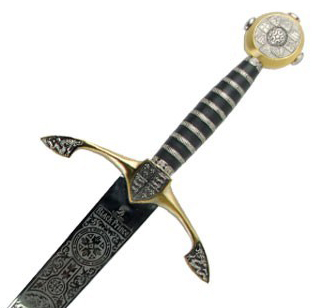
A BRIEF HISTORY OF CHARLEMAGNE
Charles I the Great, better known as Charlemagne, was born in Aachen in 742 AD and came to rule an empire in Western Europe. The first son of the King of the French, Pepin the Short, assumed the crown of the Franks when Pepin, his father, died in the year 768. Years later, specifically in 771, the lands inherited by his brother Carloman passed into his possession , to the perish the aforementioned brother without issue. In the year 774, Charlemagne signed a pact with the Pope and subjected Lombardy to his authority, first, and then the rest of Italy, although powerful nuclei of resistance subsisted in southern Italy. Two years earlier Charlemagne had launched a campaign to occupy Saxony. Once Italy was subdued (more or less) the Frankish king could count on all his troops to focus on the invasion of the aforementioned Saxony. It was not an easy undertaking because to complete the occupation they had to fight against the Saxons for no less than 12 years, from 772 to 804.
Charlemagne had built the most remarkable kingdom in the Europe of his time; but peace in their lands was far from being achieved, first, due to the uprisings that, against their authority, took place within the borders of the kingdom, and second, due to the constant fights with their enemies bordering their domains. Among the external conflicts, it is worth highlighting the conflict against the inhabitants of present-day Hungary and Croatia, which ended with the annexation of these territories. Things did not go so well in Spain, as it was defeated by the Basques in the battle of Roncesvalles, in the year 778. Roland, Charlemagne’s nephew, and protagonist of the epic song La Chanson de Roland, died there.
Due to the number of territories that he dominated under his command, many distinguish him as a forerunner of the European Union. Since the demise of the Western Roman Empire, no one had owned such a large piece of land. This, and the friendship with Pope Leo III, led the latter to crown him emperor in the year 800, giving rise to a conflict between the new Emperor and the Papacy, since Charlemagne strengthened his privileged situation over the other kingdoms. , and this bothered the Pope who maintained his hegemony in the religious field. Therefore, in the course of the Middle Ages, there is a struggle over which of the two powers, temporal and spiritual, stands out over the other.
Aachen becomes the capital of the Carolingian Empire. From his position as chancellor, a cleric dealt with both civil and church affairs. The counts were in charge of monitoring the regions of the empire. Except for border control, which was in the hands of the military. This does not mean that the emperor inhibited himself from the government of his kingdom, but that he inspected all this organization through legacies appointed by the emperor himself. Charlemagne was an extraordinary defender of the Christian faith, and within this facet,
The Christian religion constituted a cultural element of integration, stability and social order, which the emperor was in charge of cultivating: he protected the monasteries and spread Christianity in the north of his kingdom, going so far as to make it compulsory in Saxony .
That partly fictitious union of so many territories under the command of Charlemagne did not last long. Part of the responsibility is due to the will of the emperor , who had foreseen that, at his death, which occurred in Aixla.Chapelle in 814, his empire would be divided among his three sons. But two of them died, leaving the entire inheritance of their father in the hands of the only living son Ludovico Pío, who, upon his death, divided the territory among his three sons, in the Treaty of Verdun, year 843. The descendants of Charlemagne continued occupying the French crown until the year 987.
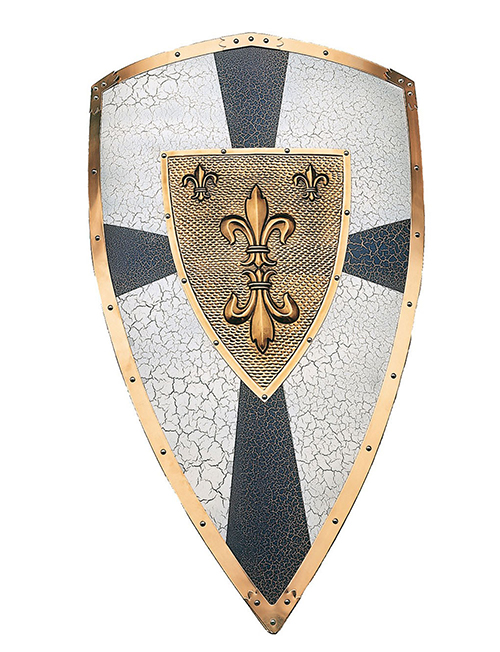
THE SWORD OF CHARLEMAGNE
The so-called Sword of Joyeuse , found in the Parisian Louvre, is one of the most glorious swords in history, which many researchers attribute to Charlemagne, although this attribution has not been clearly and precisely demonstrated. It was said of it, as of other emblematic swords of the Middle Ages, that it had magical powers and that it was used as an ornamental object in multiple ceremonies and solemnities.
Legend tells us that it was forged by Galas, a famous blacksmith, in the year 802. It took me no less than 3 years to finish it. As we said before, Joyeuse is imputed with magical powers. Its brilliance was such that it could blind its bearer’s opponents, and even more so its possessor was immune to poison.
In the epic song La Chanson de Roland, which recounts the battle of Roncesvalles, in the year 778, Charlemagne appears on horseback brandishing Joyeuse , which according to the song could change its color up to 30 times in one day. A legend tells us that, having lost Joyeuse , Charlemagne announced a prize for whoever found it and returned it. And indeed a soldier found it. The soldier, as a reward for his discovery, received from the emperor, for himself and his descendants the lands where they were. Now on that spot stands the French town of Joyeuse in the Ardèche , bearing that name in deference to the sword.
Nothing is known what happened to Joyeuse when Charlemagne died, but in 1270 a sword appeared that was recognized as Joyeuse , which was used in the coronation of many French kings. The sword was guarded by the monks in the mausoleum of the French Kings until 1505. In 1793 it was transferred to the Louvre. Today Joyeuse is exhibited as a coronation sword and is surely the most replicated sword in history.
WHAT WERE THE MOST IMPORTANT ACHIEVEMENTS OF CHARLEMAGNE?
Charlemagne is without a doubt the creator of medieval Europe. for several reasons: It established in Europe the first empire that existed since the fall of the Western Roman Empire, it attracted the Germanic peoples to live within the culture of the Franks, and it laid the foundations of vassalage within the feudal model.
HOW MANY MARKS DID THE EMPIRE OF CHARLEMAGNE HAVE?
To safeguard his empire, he invaded and instituted several border marks, which would later be the foundations of future medieval states: the Hispanic March, against the Arabs; the Breton March, against the Bretons; the Danish March, against the Danes; the Soraba March, against the Slavs; and the Eastern and Panonic Marches, on the Danube, against the Avars.
WHERE IS CHARLEMAGNE BURIED?
They say that he is buried in a tomb in the Aachen Cathedral, however, said tomb has not been found, being, in our days, still an enigma to be solved, despite the multiple investigations that have been carried out to locate it. since the death of Charlemagne, in 814. However, the bones of the first king of the Carolingian lineage are preserved in a luxurious gold chest from the 12th century that is kept in the cathedral mentioned above.
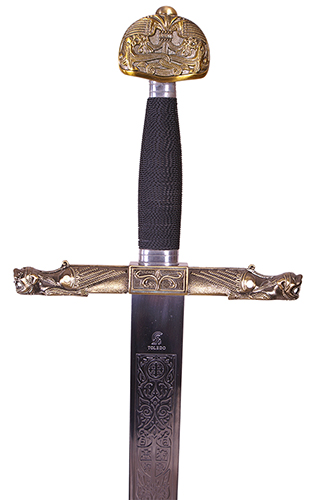
HISTORY OF CHARLES V
Carlos I of Spain and V of Germany, was the son of Juana la Loca and Felipe el Hermoso and grandson of the Catholic Monarchs and Emperor Maximilian of Austria. He was born in Ghent on January 24, 1500.
He grew up and was educated in Flanders. His native language was French. When his grandmother died, he was 4 years old and was named Prince of Castile. A year later, when his father died, he acquired the title of Duke of Burgundy, and at the age of 7 he became sovereign of the Netherlands. When in 1515 he was declared of legal age and established his court in Brussels. A year after the death of Fernando el Católico, he inherited the crown of Spain. In 1517 he set foot on Spanish land for the first time to take possession as King of Spain. I didn’t know how to speak Spanish, nor had I any idea of the situation there at the time. His retinue was made up entirely of councilors from the territories where he had lived since he was born. This displeased, and much to the nobility and the Spanish people. This caused serious conflicts between the Castilian nobility and Carlos I, so that, in a meeting of the courts, the nobles required the king to learn Spanish and respect their laws. Carlos accepted in exchange for receiving substantial credits. In 1519 his paternal grandfather Maximilian of Austria died, with which Carlos became his successor, but he had to buy the title of Emperor, which was not hereditary, and for this he went to the Fugger bankers.
Once again, the Spanish nobles opposed Carlos I, from now on Carlos V, being crowned as Holy Roman Emperor, as they foresaw 2 problems: 1 Great absences of the king from the Spanish land, and 2, Increase in taxes on the Spaniards due to the many expenses that Carlos would have in his new political position.
The predictions of the nobles were met to the millimeter. Carlos demanded new credits to cover his coronation as a champion of Christianity and left for Aachen. His suspicions were immediately confirmed because Carlos demanded new credits to finance his coronation and left the Peninsula in the direction of Aachen (Germany) to be crowned leader of Christianity. While he was out of Spain, 2 rebellions took place, the War of the Communities and the Germanías, the rioters rebelled against the taxes established by Carlos, at the same time that they recriminated the attitude of the aristocracy in this and other matters. The 2 uprisings failed, so that all of Spain was totally subdued and during his absence there were two rebellions in Spain (the War of the Communities and the Germanías) against his fiscal policy and against the aristocracy. Both uprisings were suppressed, consolidating the submission of the Peninsula to the power of Carlos V.
Carlos returned to Spain in 1522 and was on Spanish soil for the next seven years. He learned Spanish and struggled to understand it in the country for the next seven years, trying and striving to understand the personality of the Spanish, knowing that he did not enjoy much sympathy among the Spanish people.
He married his cousin Isabel of Portugal . On his honeymoon he passed through Granada, and he liked it so much that he had a summer palace built for the royal family in the Alhambra itself. Three children were born from the marriage, Felipe (future Felipe II), María and Juana. One of them was Juan de Austria, who distinguished himself as a great warrior and strategist, to the point that he reached the rank of commander of the Spanish forces.
Carlos V, in 1556, abdicated in favor of his eldest son Felipe. Of his entire reign, some 40 years, only 16 he spent in Spain. His involvement in numerous wars, and his obligations as governor of a large territory, forced him to make numerous trips.
He chose the monastery of Yuste (Cáceres) to spend the last years of his life. He chose this place to cure himself of gout, and above all to put himself at peace with God. His stay in the monastery was not very long, only two years. And there, with no other company than the friars, he gave his soul to God, on September 21, 1558, at the age of 58.
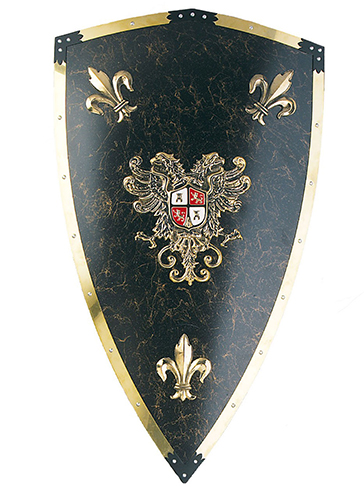
THE SWORD OF CHARLES V
The sword of Carlos V is a solemn sword whose owner was the person who held the titles of Carlos I of Spain and Carlos V of the Holy Roman Empire, perhaps the most powerful man of his time. It was forged in Milan in the 16th century and is appreciated as one of the main examples of heraldic art of the time. The sword is made of gold and its magnificent decoration consists of diamonds, emeralds and pearls. Today it can be admired within the collection of the National Archaeological Museum of Madrid.
WHAT SWORD DID THE SPANISH USE IN THE 16TH CENTURY?
In 16th century Spain the rapier was used. A weapon for use as a pointed sword, with a blade of narrow and sharp section. We can also find in this period, rapier swords with bow garnishes and quite wide blades used both as pointed and cutting.
With the general term of rapier was designated, also the sword that was used as part of the knight’s clothing, and was used to settle duels, so common at the time.
WHAT SWORD DID THE THIRDS OF FLANDERS USE?
sword of the soldiers of the tercios had a long and thin blade, with a double edge and a pointed finish. Normally the hilt used to mount a bowl, a piece of metal that protected the hand of who was holding the weapon. The blade of the sword of the soldiers of the tercios was achieved by hitting the steel plates, which gave it elasticity, located on top of an iron rod. This iron was essential so that the sword would not break. The best swords made at that time were the Biscayan ones, and also the Toledo ones, which enjoyed a well-earned fame throughout Europe.
WHAT WAS THE DAGGER OF THE THIRDS OF FLANDERS LIKE?
The dagger was a weapon that has a cutting blade finished in a pointed and sharp edge. Its length was about a third of a sword. It was an obligatory accessory for the soldiers of the Thirds of Flanders, and it was practically used throughout the 16th century. A peculiarity of these daggers is that some had 2 blades close to the tip, and three or four edges were frequently added to this.
